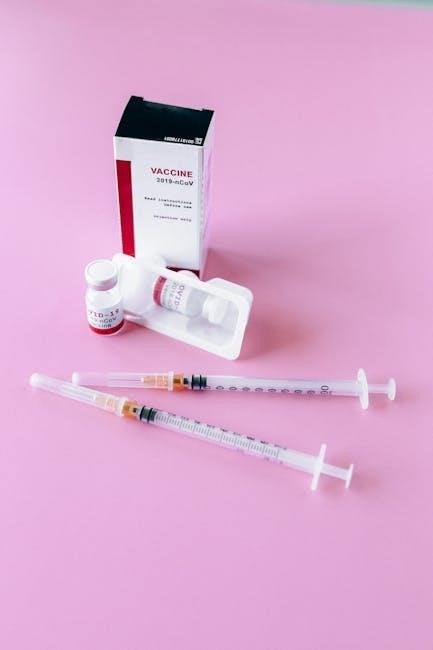medication aide study guide
Medication aides play a crucial role in healthcare, administering medications accurately, ensuring patient safety, and maintaining proper documentation. Their work is essential for effective care.
1.1. Overview of the Medication Aide Profession
Medication aides are healthcare professionals responsible for administering medications to patients in various settings, such as long-term care facilities. Their role involves ensuring accurate medication delivery, maintaining patient safety, and adhering to legal and ethical standards. Proper documentation, such as updating Medication Administration Records (MAR), is a critical part of their duties. They work under the supervision of licensed nurses and play a vital role in supporting patient care and well-being.
1.2. Key Skills and Competencies Required
Medication aides must possess strong attention to detail, organizational skills, and the ability to follow precise instructions. Proficiency in reading and interpreting medication labels is essential. They must also demonstrate effective communication skills to interact with patients and healthcare teams. Knowledge of medication classifications, dosages, and potential side effects is critical. Additionally, they should exhibit empathy, professionalism, and a commitment to ethical practices in patient care.
1.3. Importance of Accuracy in Medication Administration
Accuracy in medication administration is critical to prevent adverse reactions, overdose, or underdose. Errors can lead to severe health complications, legal consequences, and loss of patient trust. Proper identification of medications, dosages, and administration times is essential. Medication aides must ensure precise documentation in the Medication Administration Record (MAR) to maintain accountability and patient safety. Attention to detail and adherence to protocols are vital to avoid mistakes and deliver high-quality care.
Medication Administration Basics
Medication administration involves accurately following orders, understanding routes, and adhering to protocols. Proper techniques ensure safety, effectiveness, and compliance with legal standards, minimizing risks for patients.
2.1. Understanding Medication Orders and Prescriptions
Medication orders and prescriptions guide proper administration, specifying drug name, dosage, route, and frequency. Accurate interpretation is critical for safety and efficacy. Aides must verify details, ensuring alignment with prescriber instructions and patient needs. Understanding controlled substances, like Methadone, is vital for legal compliance. Clear communication and attention to detail prevent errors, ensuring medications are administered as intended and documented accurately for patient safety and accountability.
2.2. Routes of Medication Administration
Medications can be administered via various routes, including oral, intravenous (IV), intramuscular (IM), subcutaneous, topical, or inhalation. Oral administration is common for pills or liquids, while IV push delivers drugs directly into the bloodstream. Accurate route adherence ensures drug efficacy and patient safety. Understanding proper administration techniques and potential risks, such as infection or overdose, is crucial for aides to deliver care effectively and prevent complications.
2.3. Legal and Ethical Considerations
Medication aides must adhere to legal and ethical standards, ensuring patient safety and rights. They must follow physician orders, maintain accurate records, and respect patient confidentiality. Administering medications without proper authorization is illegal. Ethical practices include obtaining informed consent, avoiding negligence, and upholding patient dignity. Failure to comply can result in legal consequences, emphasizing the importance of understanding and adhering to healthcare policies and regulations.

Controlled Substances and Handling Procedures
Controlled substances require strict handling to prevent misuse. Medication aides must ensure secure storage, accurate documentation, and compliance with legal standards to minimize diversion and maintain safety.
3.1. Classification of Controlled Substances
Controlled substances are categorized into schedules based on their potential for abuse and medical value. Schedule I drugs, like heroin, have high abuse potential and no accepted use. Schedule II, such as methadone, have medical use but high abuse risk. Schedules III and IV include drugs with lower abuse potential, like anabolic steroids and benzodiazepines. Schedule V drugs, such as cough medicines, have the lowest abuse risk. Understanding these classifications is vital for proper handling and documentation.
3.2. Proper Storage and Handling
Proper storage and handling of controlled substances are critical to prevent diversion and ensure safety. Medications should be stored in locked cabinets or secure areas, with limited access. Schedule II drugs require double-locking. Regular inventory counts and documentation are essential. Medications must be handled in well-lit areas, and tamper-evident containers should be used. Proper disposal methods, such as DEA-approved facilities, must be followed to prevent misuse and environmental contamination. Expired or damaged medications should be segregated and disposed of appropriately.
Accurate and complete documentation is essential when handling controlled substances. Medication aides must maintain detailed records, including dates, times, dosages, and patient responses. Documentation should be done immediately after administration to ensure accuracy. The use of Medication Administration Records (MAR) or electronic MAR (eMAR) is standard. Legibility and compliance with legal standards are critical to prevent errors and ensure accountability. Proper documentation also helps in tracking inventory and identifying potential diversion or misuse of controlled substances.

Medication Administration Record (MAR)
3.3. Documentation Requirements
Documentation is critical for accountability and patient safety. Medication aides must record dosages, administration times, and patient responses accurately. Using MAR or eMAR ensures compliance and clarity. Proper documentation helps track controlled substances, prevents diversion, and supports legal standards. Accurate records also aid in audits and continuity of care. Timely and precise documentation is essential for effective medication management and accountability. It ensures transparency and safety in healthcare settings.
4.1. Purpose and Components of MAR
The Medication Administration Record (MAR) is a legal document tracking medication administration, ensuring accuracy and accountability. It includes patient details, prescribed medications, dosages, administration times, and routes. MAR components also cover the healthcare provider’s orders, start and stop dates for medications, and any changes. This record helps prevent errors, supports continuity of care, and complies with legal standards. Accurate MAR documentation is vital for patient safety and effective medication management.
4.2. Accurate Documentation Techniques
Accurate documentation in MAR ensures patient safety and legal compliance. Techniques include recording medications immediately after administration, using clear handwriting or electronic systems, and avoiding abbreviations. Double-checking orders, dosages, and patient identities prevents errors. Timely updates and legible entries are crucial. Documentation must include the date, time, medication name, dose, and route. Missing or illegible entries can lead to legal issues and compromised care. Consistency and attention to detail are essential for reliable records.
4;3. Electronic MAR (eMAR) vs. Paper MAR
Electronic MAR (eMAR) offers real-time updates, barcode scanning, and automated alerts, reducing medication errors. Paper MAR relies on manual documentation, requiring precise handwriting. While eMAR improves efficiency and accuracy, Paper MAR remains effective if meticulous. Both systems demand attention to detail to ensure patient safety and compliance with healthcare standards.

Patient Safety and Error Prevention
Patient safety is critical. Medication aides must minimize errors through accurate documentation, clear communication, and vigilant monitoring. Proper protocols ensure safe, effective care, reducing risks and improving outcomes.
5.1. Identifying High-Risk Medications
High-risk medications, such as opioids, anticoagulants, and insulin, require careful handling due to their narrow therapeutic indices and potential for severe side effects. These medications demand precise dosing and monitoring to prevent adverse reactions. Medication aides must double-check orders, use barcode scanning, and monitor patients closely to ensure safe administration. Proper documentation and communication are crucial to minimize risks and improve patient outcomes.
5.2. Strategies to Minimize Medication Errors
To minimize medication errors, aides should verify orders, use barcode scanning, and ensure medications are labeled correctly. Double-checking doses, routes, and patient identities is essential. Using electronic MAR (eMAR) systems reduces transcription errors. Open communication with healthcare teams and patients, along with continuous education, enhances safety. Regular monitoring and documentation of administration help identify and address potential issues promptly, ensuring accurate and safe medication delivery.
5.3. Role of Allergy Checks and Monitoring
Allergy checks are critical to prevent adverse reactions. Aides must verify allergies before administration, using patient records or allergy bracelets. Monitoring for signs of allergic reactions, such as rash or difficulty breathing, is essential. Documentation of allergies and reactions ensures continuity of care. Accurate communication with healthcare teams and patients enhances safety, preventing potential harm and improving patient outcomes through vigilant monitoring and timely intervention.

Special Considerations in Medication Administration
Special considerations include pediatric and geriatric administration, handling IV medications, and managing interactions. Proper techniques ensure safety and efficacy in various patient populations and situations and conditions.
6.1. Pediatric and Geriatric Medication Administration
Medication administration in pediatric and geriatric populations requires special attention. For children, dosages are often weight-based, and formulations may need to be age-appropriate. Geriatric patients may have chronic conditions, polypharmacy, and sensitivity to side effects. Accurate documentation and monitoring are critical to ensure safety and efficacy in these vulnerable groups, minimizing risks and optimizing therapeutic outcomes while adhering to best practices.
6.2. Handling IV Medications and Push Administration
IV push administration involves introducing medications directly into a patient’s bloodstream, requiring aseptic technique and careful preparation. Proper catheter verification, medication labeling, and patient monitoring are essential. Administering slowly helps minimize adverse reactions. Following facility protocols ensures safety and effectiveness. Accurate documentation is crucial for patient care continuity.
6.3. Managing Medication Interactions and Side Effects
Medication aides must monitor patients for side effects and potential drug interactions. Identifying high-risk medications and educating patients on symptoms is crucial. Proper documentation of adverse reactions ensures timely interventions. Collaborating with healthcare providers to adjust treatments minimizes complications; Proactive monitoring and clear communication are essential to safeguard patient well-being and prevent harmful interactions.
Preparing for the Certified Medication Aide Exam
Understanding the exam format and content is key to success. Effective study strategies, utilizing resources, and test-taking tips help candidates prepare thoroughly for the certification.
7.1. Understanding the Exam Format and Content
Understanding the exam format and content is essential for effective preparation. The Certified Medication Aide Exam typically includes multiple-choice questions assessing knowledge of medication administration, legal responsibilities, and patient safety. Familiarizing oneself with the test structure, timing, and weighting of topics ensures a focused study approach. Reviewing practice questions and exam guidelines helps candidates anticipate challenges and refine their test-taking strategies for optimal performance.
7.2. Effective Study Strategies and Resources
Effective study strategies include active learning, time management, and using reliable resources. Utilize flashcards for key terms, practice exams for assessment, and online modules for interactive learning. Focus on understanding concepts rather than rote memorization. Join study groups or forums for peer support. Allocate dedicated time for reviewing notes and industry guidelines. Leveraging these strategies and resources enhances comprehension, retention, and confidence, ensuring thorough preparation for the exam.
7.3. Test-Taking Tips for Success
Skim through the entire test first to understand its structure. Read each question carefully, ensuring you understand what is being asked. Manage your time effectively, allocating more time to high-weight questions. Eliminate obviously incorrect answers to improve your chances of selecting the right one. Stay calm and avoid second-guessing your initial responses. Review your answers if time permits. Use mnemonics or acronyms to aid memory during the test.

